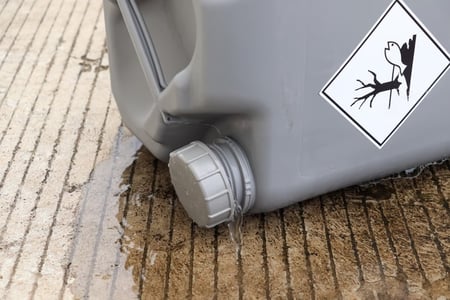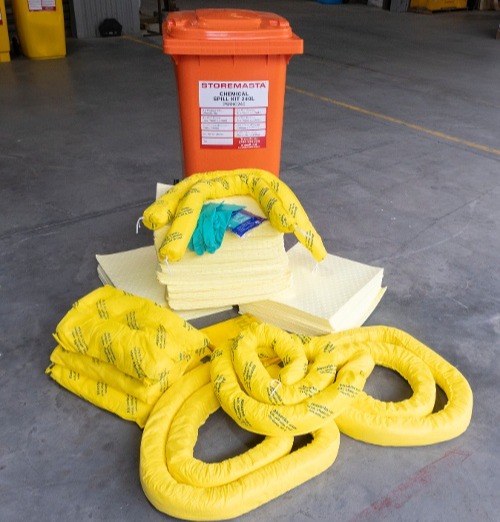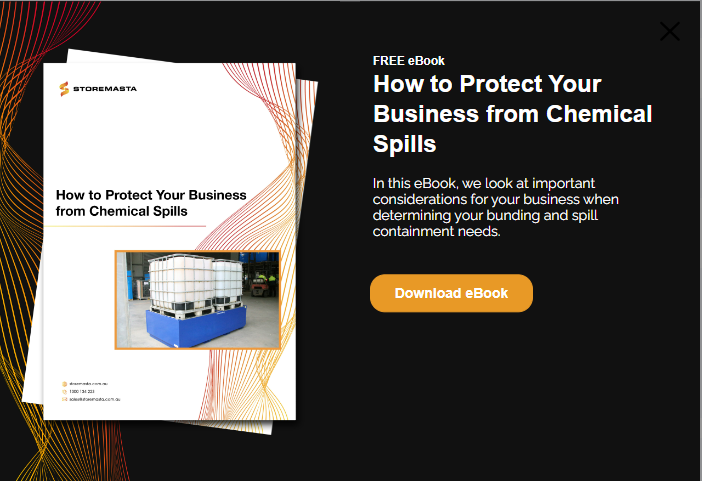Preventing a chemical spill in your workplace is one of the most crucial considerations when looking at HAZCHEM safety. Due to the toxic, corrosive, flammable or reactive properties of dangerous goods, even small amounts of a spilled chemical can cause major health and safety issues for organisations. If you’re carrying multiple chemical products in your workplace, spillage can become an even bigger risk as incompatible hazardous chemicals can react with each other. This can result in a wide range of incidents from fire to dangerous gas emissions. If you’re storing large quantities of chemicals in the outdoor environment, spillage could quickly spread to private or public places, affecting the air quality of nearby buildings, creating a fire or explosion risk, or contaminating soil and water sources. However, there are some simple steps that you can take if you’re serious about preventing a chemical spill in your business.
In this blog, we’ll be highlighting how streamlined purchasing, good housekeeping, and regular site inspections and safety audits can combine to help you improve HAZCHEM safety at your site.
REMEMBER: Under the WHS Act, an uncontrolled chemical spill or leakage is classed as a dangerous incident. The Regulator in your state or territory must be notified in writing as soon as possible after a chemical spill.
Step 1: Purchasing Minimal Stocks of Hazardous Chemicals
One of the easiest ways to reduce your spill risk is by taking a good look at your chemical ordering process. An effective chemical management program will have streamlined purchasing procedures.
To achieve this, make sure that you build solid relationships with your chemical suppliers and aim to keep stocks as low as possible. As quantities of hazardous chemicals increase, so does the potential for leaks and spillage.
When you’re dealing with larger volumes of hazardous substances during a spill, there will be a greater volume of air-borne contaminants. Due to the emission of hazardous vapours and gases during such an incident, the flammable zone will also widen — increasing the likelihood of the vapours meeting an ignition source.

Chemical spills involving flammable liquids will increase the risk of hazardous vapour emissions and ignition.
A chemical supplier who is willing to deliver smaller quantities more often enables you to minimise the stocks you hold in your chemical stores.
Your purchasing program should have procedures to ensure:
Safe Receiving Procedures for Chemical Deliveries
- Orders are received at the designated time, so staff are available to receive the chemicals.
- Chemical deliveries are immediately inspected for any damage or leaks.
- Workers have been suitably trained and receive enough supervision to ensure procedures are being followed.
- Mechanical lifting devices, forklifts, and trolleys are available and in working order.
- The availability of spill kits in all chemical receiving, handling and storage areas.
- Staff trained to handle chemical deliveries in a safe and methodical way, as well as being able to effectively clean up the spill if one occurs.
Promptly Store Chemicals to Reduce Risk of Hazardous Chemical Spills
- The packages are put away in suitable chemical storage as soon as they are received.
- Chemicals are only ordered if the applicable chemical storage facility is onsite and available for new shipments.
- Personnel responsible for these tasks must understand how to properly store chemicals to meet compliance and safety obligations.
WARNING: We often see in the chemical safety audits we conduct for our clients, stacks of chemical containers left outside or piled up next to pallets and chemical stores. Many of these clients have already invested in the correct chemical safety cabinets and bunded pallets, but a breakdown in their purchasing and delivery procedures has created an unnecessary spill hazard.
Step 2: Chemical Decanting and Storage
One of the most effective ways to prevent chemical spills is to use secondary containment equipment when storing and decanting your hazardous chemicals.
Secondary containment, otherwise known as chemical bunding, can either fully encapsulate the original container or sit underneath. The bunding is designed to effectively contain any chemical leaks or spills which may occur during usage or storage.
To comply with Australian WHS legislation and safety standards you should consider:
Spill Bunding
- Under-pallet bunding where packaged chemicals, drums and IBCs are stored on top of pallets.
- Drip trays with raised edges for simple decanting areas.
- Chemical safety cabinets with inbuilt spill sumps for flammable liquids, corrosives and larger quantities of any hazardous chemical.
Decanting and Handling Equipment
- Attaching decanting assistors to your storage equipment to reduce leaks and spills while dispensing.
- Bunded drum dollies for moving chemicals around the warehouse.
Spill Kits and Spill Clean Up
- Appropriate spill kits must be available in all handling and storage areas.
- Specific staff should be adequately trained to contain and clean up the spill.
- Safe procedures need to be developed for the correct disposal of soiled spill clean up materials, wasted chemicals and any resulting effluent.
However, you should keep in mind that chemical stores and bunded pallets aren’t going to be effective if they’re overloaded past their maximum chemical capacity. They also won’t act as an adequate hazard control measure if they’re not used or maintained properly.

The provision of spill kits, spill bunding, bunded chemical storage, decanting and handling equipment is essential for site safety.
To make sure that your equipment continues to provide risk reduction for your organisation, you should create safety procedures for correct housekeeping practices, including the following:
General Chemical Safety and Storage
- Put chemical containers, drums and IBCs back in their chemical cabinet or store immediately after use.
- Inspect chemical containers to determine the use-by-dates.
- Clean out bunding as soon as a leak or spill occurs.
- Monitor your bunded storage and secondary containment systems for any signs of wear and tear.
- Inspect chemical packages for any signs of damage, leaks or age.
- Put chemical containers, drums and IBCs back in their cabinet or store immediately after use.
- Inspect chemical containers to determine the use-by-dates.
- Clean out bunding as soon as a leak or spill occurs.
- Monitor your bunded storage and secondary containment systems for any signs of wear and tear.
WARNING: One the most unnecessary hazards we identify during chemical safety audits are bunds being overloaded or used incorrectly. We’ve seen stacks of hazardous chemicals left sitting on the ground while non-hazardous substances are stored on the bunded pallets. This issue could be easily rectified with suitable training and supervision.
Step 3: Site Inspections and Safety Audits
While you may have reviewed your chemical ordering practices and maintained your secondary containment systems, you must continue to review your worksite if you want to achieve ongoing compliance and safety.
We highly recommend conducting regular site inspections and safety audits, so that you can reduce spillage risk in your organisation. Your safety audit should evaluate the potential for chemical spills from both a macro-level and micro-level perspective.
REMEMBER: An uncontrolled release of flammable, corrosive or toxic gases under pressure can be just as dangerous as a liquid chemical spill. Compressed gases are considered hazardous chemicals as well as Dangerous Goods and must be considered in your risk assessments for chemical spills.
At a micro-level your site inspections would regularly review the integrity of chemical containers, safety cabinets and under-pallet bunding.
Check for:
Correct Chemical Storage
- Containers left in work areas or on benches without being returned to storage.
- Leaking flammable liquids or hazardous chemical containers.
- Chemical containers stacked improperly or too high, making them vulnerable to falling over.
- Gas cylinders not correctly restrained.
Chemical Packages
- Old containers that have cracked or become brittle from years of use.
- Worn, damaged and loose fittings on gas cylinders.
- Chemical containers left open or with missing/broken lids.
- Empty containers or gas cylinders left lying around the worksite can still pose risk, so procedures must be implemented to store or decontaminate ‘empty’ containers.
Clean up the Spill
From a macro-level, your chemical audit would take a wider look at the quantities of hazardous chemicals kept in certain areas. It would note work practices — or plant and machinery that’s in close proximity to chemical stores — that could damage containers or impact/penetrate your stores.
Your audit checklist might contain trigger points and flags for:
Impact Damage
- Bulk transfer or delivery vehicles turning near chemical stores (could impact the store).
- Forklift trucks operating near chemical stores (could impact the store and cause a spill).
- Chemical stores located near perimeter fences (stores could be impacted by external vehicles, falling branches and tree debris).
Chemical Handling Accidents
- Handling of chemicals carried out in busy work areas (increasing risk of people causing a chemical container to spill).
- The condition of outside chemical stores (are the stores at risk of corrosion, deterioration or chemical leaks due to being placed in the harsh outdoor environment?).
- Forklift placing chemical drums into an outdoor store.
REMEMBER: Part of the audit process should be looking at the ways in which work practices, as well as plant and machinery, can increase the likelihood of hazardous spillage.
How to Prevent Chemical Spills in your Workplace
As we’ve detailed in this blog, there are 3 simple and easy ways that you can reduce risk with a spilled chemical in your workplace. Preventing spillage is not only an important part of your HAZCHEM safety program, but a legal obligation under Australian law.
To find out more about protecting your business from chemical spills, you can download our FREE eBook. We highlight the hazards that are associated with chemical spills and offer some expert advice on the steps you need to take to prevent chemical spills in your own workplace.
Joining the team as a Dangerous Goods Storage Consultant, Melissa Hampton became Storemasta's Marketing Manager in late 2021. With extensive knowledge and experience in chemical compliance, Melissa is responsible for leading the Marketing team and helping shape their marketing strategy. In her spare time, you can find Melissa hiking, swimming and enjoying the great outdoors in beautiful north-west Tasmania.

